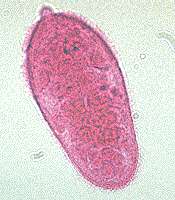Many parasites transmitted through water actively seek their next host. They can be selective about the host that they choose. Parasites must be mobile to seek out hosts, and often have sensory structures that enable them to seek out habitats frequented by their hosts, as well as the host organisms themselves.
Adult copepods such as Ergasilus (top) and Argulus (bottom) simply detach and swim to find a new host.


Parasitic crustaceans which are permanently attached as adults will use their larval stages, such as this nauplius, to actively seek a new host.

Monogeneans use a free-swimming oncomiracidium to find new hosts. The adults can also transfer from host to host by direct transfer. Adult Gyrodactylus (below) move from one fish to another when fish are in crowded conditions, such as in aquaculture situations.

Miracidia of many species of Digenea hatch from the egg and actively seek a snail first intermediate host. the miracidium is covered with cilia that enable locomotion, and they have anterior sensory structures that allow them to track host chemical trails. Miracidia also possess penetration glands or stylets to help penetrate the epidermis of the snail.


Cercariae of most species of Digenea leave the snail in which they are produced. Most can swim.
Cercariae of Fasciola search for suitable plant material on which to encyst. They have a long tail (T) for swimming and the soma (S), or main body region, contains cystogenous glands for secreting the cyst.

Cercariae of Plagiorchis swim in search of a mosquito larva to penetrate. They have a small stylet in the oral cavity that they use to penetrate the cuticle of the intermediate host.

Cercariae of Schistosoma swim in search of a vertebrate definitive host to penetrate. They have eyespots to orient themselves in the water column, and a forked tail that allows them to sink slowly after swimming top the surface. These cercariae have glands to help them penetrate the skin of their host.

Cercariae of Proterometra swim until they are eaten by their fish definitive host.
